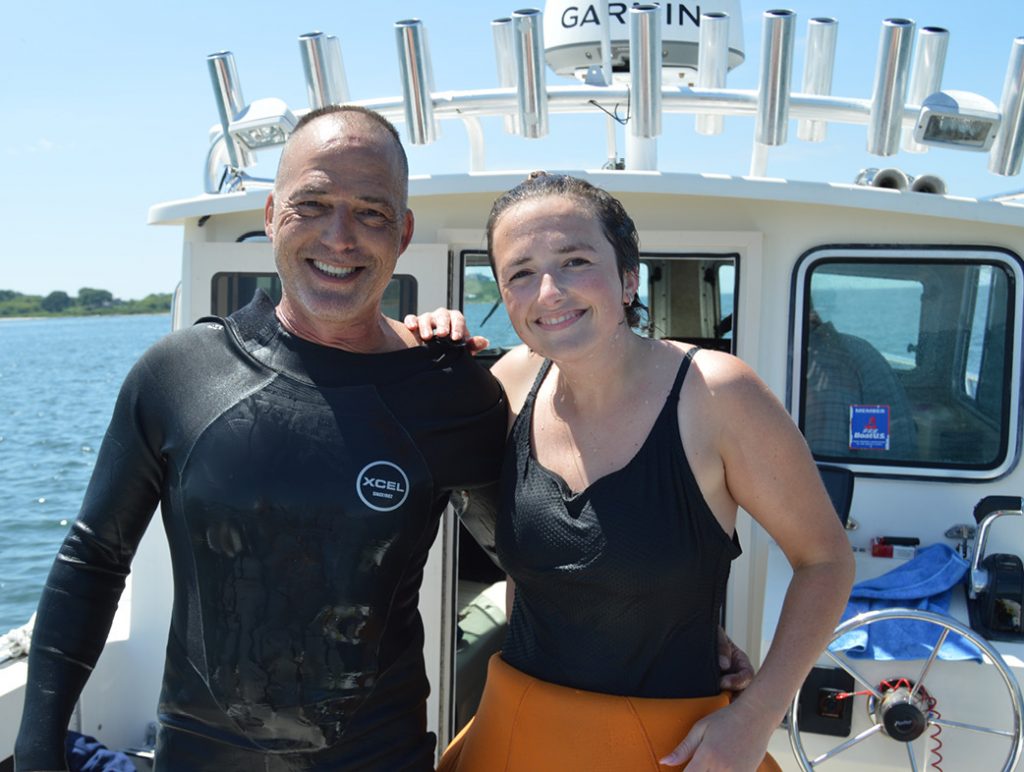By David Seigerman, clean water communications specialist
There are better ways to spend your time than watching grass grow. But believe it or not, there are worse ways, too. Like waiting for grass to grow and being unable to watch. It’s that particular brand of torturous tedium that awaits Rob Vasiluth over the next several months.
“I can’t wait for June,” said Vasiluth, founder of SAVE Environmental, which is working with Save the Sound, the Cornell Cooperative Extension, and 11th Hour Racing to restore eelgrass in Long Island Sound, where it once flourished.
In June, just a few idle months down the road, Vasiluth plans to return to the two-acre plot in Smithtown Bay where Phase III of the project culminated the day before Thanksgiving. Vasiluth spent that morning feeding trays of hatchery clams into a machine of his own design, which propelled them down an eight-lane chute that extended off the back of the boat. On that next visit, he’ll be underwater in dive gear, hoping to find new eelgrass plants sprouted along that stretch of Sound floor.

Rob Vasiluth, SAVE Environmental, and Emma DeLoughry, Soundkeeper associate
You see, those were not ordinary hatchery clams ker-plopping into the Bay like so many skipping stones. They were a living army, 8,500 strong, each clam bearing up to 10 eelgrass seeds glued to the apex of its shell. Roughly 85,000 seeds went into the water in the span of a half-hour that sunny Wednesday, delivered down from the surface through eight or nine feet of November-cold water to the soil, where they were implanted as the clams buried themselves. When the seeds pop open in the spring, they will separate from their shelled hosts and take root where they settle in the substrate.
If everything goes as planned, a new eelgrass meadow will be born off Sunken Meadow State Park. “We’re using an animal to plant an underwater forest,” said Vasiluth, an operator of heavy machinery by trade, who envisioned this experimental approach.
After decades of depletion – only 1,465 acres of eelgrass were mapped by the Long Island Sound Study in 2017, the latest measure available – the solution to eelgrass restoration might just be biomimicry. “Mimicking nature. That’s all we’re doing,” said Vasiluth. “We’re forcing the clam to take seeds with it when it buries itself. That’s the mechanical advantage we’re using with this animal.”
The seeds were harvested in the northeasternmost corner of the Sound, the one area where eelgrass still thrives, thanks to a jackpot combination of ideal water quality conditions including the constant flushing with cool, clean waters of the Atlantic Ocean. Over the course of three hour-long dives last summer, Vasiluth and Soundkeeper associate Emma DeLoughry of Save the Sound picked enough reproductive shoots to provide the bounty of seeds for the planting in the Western Basin.
A series of bubbling saltwater tanks at the Cornell Cooperative Extension facility in Southold, NY, kept the seeds alive into the fall as they awaited their affixing to the clams housed in neighboring tanks. Vasiluth and a steady rotation of volunteers spent some long days carefully gluing the seeds to the shells – as hands-on an approach to restoration as can be.
Eventually, the seeds and their delivery systems were ready for deployment in a permitted location determined to have conditions favorable for eelgrass, from the composition of the substrate to sufficient light penetration. “There is a strong network of people working on trying to reverse the decline of eelgrass in the Sound from Cornell, UConn, and TNC to Stony Brook University and the EPA Long Island Sound Study, to name a few. Researchers are employing a variety of planting techniques, of which Rob’s is one we are supporting,” said Long Island Soundkeeper Bill Lucey. “If we can get eelgrass to hold on in Smithtown for at least three years, that means we can start looking into expanding and combining new techniques from other practitioners.”
That would be a turning point for the health of the Sound. Lucey considers eelgrass to be “a keystone component of a healthy ecosystem.” It provides habitat for fish and other aquatic life, presents a defense against coastal acidification and coastal erosion, and even serves as a carbon sink, capturing and sequestering carbon at rates faster than terrestrial forests. “The amount of things eelgrass does, it’s like this miracle plant,” said Vasiluth, who is hoping to harvest a million seeds in 2023. “I didn’t know any of that starting out. I just knew it was missing.”
Vasiluth knows more now. He knows what’s at stake and what success could mean to the future of Long Island Sound. Which is what makes this phase of the project – the waiting – the hardest part. ■




